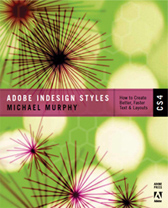Episode 37: Long Documents, Part 5 – Generating an Index (VIDEO)
The thrilling conclusion of the Long Documents series is finally here! In this episode, I wrap it all up with some last indexing shortcuts, generating an index (and how it differs from generating a TOC), formatting and updating an index, and making your index interactive in a PDF.
Watch the episode here (17:18 | 38.1 MB), or you can subscribe via iTunes.
You can follow any responses to this entry through the RSS 2.0 feed. Both comments and pings are currently closed.



April 17th, 2008 at 12:51 pm
Thank you! The indexing has helped so much! Sometimes I need to refreshin my memory and this video is wonderful!
Wendy
June 2nd, 2008 at 11:48 am
Michael,
This was excellent for tying together what I knew about Indexing in InDesign.
The only thing I had hoped to learn that I did not was how to automate adding a list of peoples names from a text file as references in the index… i.e. I have a text file with a long list of names John Doe, Bill Smith, etc. and want to automatically create an index with proper names (Doe, John – Smith, Bill, etc) for every occurrence in the book.
In other words, rather than going through the entire book and hitting (Command-Option-Shift ]) on each occurrence, I have the advantage of having a supplied text file with which I want to add automatically to the index.
Is this possible?
June 2nd, 2008 at 7:13 pm
Ken —
It’s not possible with InDesign’s built-in (and limited) indexing function, unfortunately. You might want to look into a third-party solution like Virginia Systems Sonar Bookends. See http://www.virginiasystems.com/products.html for more info.
July 1st, 2008 at 8:32 pm
Hello,
thank you very much for helping us to get into indexing with indesign. Still: I’ve got three questions I’d like to put forward – asking for your support:
1. How can one create TWO indexes in one very indesign-book? I have to create one index for names and another index for subjects; and since I don’t want the names and subjects to appear in one and the same chapter, I do have to create two separate indexes – but indesign does not let me do this. What am I to do in order to get this task done?
2. Take the name “Michael Murphyâ€: I want to index its occurrence throughout the book in all variations imaginable, like “Michael Murphys†(German) or “Michael Murphy’s†etc. Can I get indesign to do all this at once or do I have to go the painful way and look for all variations separately – and then group them below on topic?
3. Is there any other third-party software suggestion besides Sonar for getting indexing stuff done? (I downloaded the trial version, but it was not the 6.7 for mac but the 6.6 and I did not even get it to work, anyway. I wouldn’t buy stuff I can’t properly test in advance.)
Looking desperately forward to read your suggestions or even solutions,
Best,
waine
January 20th, 2009 at 6:47 am
Hi Waine,
Did anyone ever reply to your post? I’m also desperate to know. Need to have two separate indexes in the same book. Going over the same ground a second time is painful.
Anna
April 2nd, 2009 at 6:08 pm
Thanks very much for the awesome InDesign index knowledge, however I still have a major problem with my project.
I have a 200 page catalog, most of it being pricing info in tables with model number, price, etc. I need to index every single model number (4800+ entries). Luckily I have a list of the model numbers. But this does not seem to help. Here are my 2 approaches and why they aren’t wroking.
1. I can populate the index topics from my pre-made list. Brilliant. I have done this by both creating the PB text box like Michael, and by importing topics from a duplicate file. So this leaves me with either a PB reference or no reference (I tried the importing to see if new options would come to light). So now I have to double click EVERY TOPIC to be able to use the “add all” button, so that it finds the other instances!?
2. I don’t mind, at this point, going though entire swaths of the book highlighting the “Model Number” column in my tables and using the Shift+Option+Command+[ command. But nothing happens because the CELL is highlighted essentially, not the TEXT contents of a cell. Is there a way to highlight contents only, from multiple cells?
I tried a few scripts, with no good results. Suggestions anyone?? Thank you!
Meghan
April 3rd, 2009 at 9:11 am
Meghan —
It sounds to me like you may be using the wrong long document feature to solve this problem. Do you need to do one unified index of everything in the catalog, with the product model numbers interspersed throughout? Or do you need a separate “index of model numbers” listing (almost like one might do an index to advertisers in a magazine, or an index to figures in a book)? If the latter is the case, you may be better off using the Table of Contents feature to build a model number-specific TOC, separate from an overall index.
Based on your description, you’ve got model numbers in tables. I’m assuming that the model numbers are in a cell of their own. If so, you can assign a paragraph style to the model numbers that’s used only for those model numbers and is not applied to any other text. Since a Table of Contents seeks out all instances of a paragraph style and gathers the text that uses it (along with the page number), you could build your model number “index” that way. The TOC feature has an option to sort alphabetically, so instead of a page number order (which might be a less logical way to list it for the reader), you’d have an alpha-sorted list of model numbers and the page numbers in the catalog on which they appear.
If the model numbers need to be grouped under a category (i.e., “pumps” or “fasteners”), you could also use a unique paragraph style for where that category name appears within the catalog and use that in the TOC as well.
If you’re not needing to do a “proper” index that also contains other information, and you’re only building a reference to model numbers and the page on which they appear, the TOC route is probably the way to go…and it’s a hell of a lot faster and easier.
April 7th, 2009 at 10:28 am
Michael, Thanks for your reply. You are so right. I need to use the TOC feature. A separate “Model Number Index” is exactly what I’m doing. (Good thing I already watched the TOC video!!)
April 8th, 2009 at 7:33 pm
@Waine and Anna —
Sorry for the slow reply, Waine. Shame on me for not getting back to you sooner. Unfortunately, books or individual documents can only have one index. InDesign can’t track more than one. I’m not sure if a plug-in like Sonar Bookends from Virginia Systems can do multiple indexes, but it’s a far better indexing solution than InDesign’s built-in index feature. You had it right when you used the word “painful,” Waine.
April 16th, 2009 at 8:06 am
I have a 350 page book with 10 chapters within it. I have created an index but when I generate the index I get some errors. Sometimes whole topics are missing (often at the end of the letter range), sometimes references are missing from a topic whilst others are present and sometimes page references are actually wrong! I have tried opening the affected the topics and references and have generated the index several times. Bemused.
Chris
April 17th, 2009 at 10:35 am
Chris — Indexing is a strange and fussy feature. Because of that, it’s difficult for me to diagnose your problem just based on the description. Is there any consistency in the problems, or are they totally random? Do you get different results when generating the index each time with the same settings? More detail or an example (you can e-mail screenshots if that helps: send them to info at theindesigner dot com) would definitely help.
June 9th, 2009 at 10:41 am
I am having a similar problem as Chris. I’m indexing several documents in a book, but when I generate the index, it randomly doesn’t include some of the page numbers that I have indexed. It will still generate the topic and some of the page numbers, but not all.
June 9th, 2009 at 11:10 am
@Chris and Marci —
Are you running CS3 or CS4? If CS3, which version? Have you been running the automatic updates. I may be grasping at straws here, but Indexing was broken for a time in CS3 and fixed with an interim update.
June 11th, 2009 at 9:38 am
I’m running CS3 version 5. I read here that this has been a problem with CS3: http://kb2.adobe.com/cps/402/kb402463.html
Unfortunately I’m using a university computer and I don’t have access to CS4. Looks like my solution is to either use CS4 or CS3 with updates. What do you think? Thanks.
June 11th, 2009 at 10:15 am
Update: once I imported topics from all of the chapters into my index and then regenerated it, the missing topics and pages showed up!
July 20th, 2009 at 11:30 am
OK, I need a work-around for the multiple indices issue. I have to include 3 indices: subject, authors, source texts.
Would it be possible to do a “save as” of the entire book once we have finished with ALL tweaking that would affect page layout and then build a different index in each of the books, then add the three generated indices into the original book? In other words, if we don’t “update” the index, could we have three separate indices in one book that were generated by the duplicate books? Thanks.
April 4th, 2010 at 3:26 pm
Hello,
I just want to share another way to organize information, which is not visible but used in the TOC.
Instead of changing the layer style to invisible, it may be useful to change the style to non-printing.
The advantage is, that you can still see your information, but when creating the PDF, it’s not included. And you don’t have to switch between visible and non-visible every time.
I often use it in Illustrator, but it works in InDesign very well, too.
I hope you can understand what I mean, because english is not very well, a foreign language for me.
October 7th, 2010 at 2:15 pm
Hi,
I´m trying to import an entire topics list at once with the
fantastic “Shift-Command-Option_[“shortcut and it doesn´t respond.
I´m using CS4. Is there a different set of command keys for that operation CS4? What else could I be doing wrong?
Gratefully,
Greg